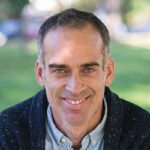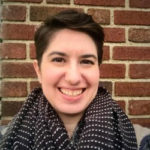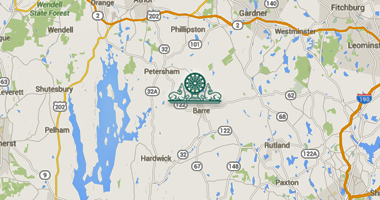
Pascal Auclair has been immersed in Buddhist practice and study since 1997, sitting retreats in Asia and America with revered monastics and lay teachers. He has been mentored by Joseph Goldstein and Jack Kornfield at the Insight Meditation Society (IMS) in Massachusetts and Spirit Rock Meditation Center in California, where he is now enjoying teaching retreats. Pascal teaches in North America and in Europe. He is a co-founder of True North Insight and one of TNI’s Guiding Teachers. He was interviewed by our graduate assistant, Eva Seligman.

Eva Seligman is a Master of Divinity candidate at Harvard Divinity School, where she studies the entanglement of Buddhism and Colonialism. She works as a graduate assistant at BCBS.
A pdf version of this interview can be downloaded here.
Eva Seligman: You came to Buddhism in 1997, 24 years ago. I imagine that where you are now is quite different from where you were then. I’m curious to hear about what some of those changes are.
Pascal Auclair: For the first five to seven years, the Dharma seemed outside. I was in Canada, I was not plugged in any communities there. The Dharma, to me, was where I practiced. It was at Bodhgaya, in retreats at the Burmese Vihara, and at IMS. There was a sense that it was outside, somewhere else, and in another country. I had to cross the Canadian/US border to go to IMS to practice. At the time, being HIV positive meant I could be refused entry into the States, so there was always stress. I had to send the pills that I needed to survive through the postal system, hoping they would get there at the same time.
There was a definite moment while I was sitting a six-week retreat at IMS. I remember being in the Dharma Hall and suddenly there was a shift. There was definitely a before and after. Suddenly, the Dharma was inside of me. Suddenly there was no more fear of not being able to come back to the US as an HIV-positive person, or not being able to travel to Asia to practice, or not having a community to practice with in Canada. This was not a problem anymore. It vanished.
I don’t know how to describe it, suddenly the mind or the heart opened to a new paradigm. Suddenly I knew this is in me. Before, I thought I had to listen to dharma talks, to get it from outside. After, there was a confidence that the tools are there inside.
The other major shift was when I started doing teacher training. Before this, retreat was a place to isolate myself with the community or alone in the woods, to not talk to others. It was associated with silence, with nature. Even on the long retreat, we meet the teacher twice for 15 minutes every week. It was solitary, silent.
And suddenly, I entered the teacher training. Suddenly there are 24 of us. Suddenly, it’s highly relational.
I remember the shock. We would gather for a week of training, with a curriculum to go through with Joseph Goldstein or with Jack Kornfield. The training I did was held by Spirit Rock and IMS, it was a joint training. So we would do one of these weeks, with Jack and the different people that he would invite. And then we would go to the East Coast and do a week with Joseph and Carol Wilson and Guy Armstrong.
I remember the first day I was sitting there and we were having, a conversation about some aspect of the Dharma and suddenly there was a very big sense that… oh, that’s the next phase of my practice I’m entering. And that phase is going to be relational.
Even signing up to do the training the four-year training, it never occurred to me that my practice would shift shape that much. I was really happy about this, very excited to discover this. It didn’t take long to understand that this thing needed speech and the friction and the beauty of community and relationships.
It was also the ignition of starting to understand social location. In this training there were I would say powerful beings, Larry Yang, Anushka Fernandopulle, Gina Sharp, Spring Washam and this was named, the power play in a room. So many things happened in that first week of the training, my mind opened up to oh, this is going to be relational. And then, Oh, my God, there’s a whole other layer of perception of understanding what is happening in a room that I know basically nothing about, that I basically never considered. And here is Larry Yang, who is considering everything that is happening through this lens and he’s naming it.
For example, somebody in the group mentioned that it was possible for the men in the group to only talk after a woman, to put it in binary language. And I remember it was a shock to even consider this. And right then and there I vowed to do this for that training. Now, maybe I would think these days, I won’t talk right after another cis-male, just to help me see what’s going on in the room.
ES: These two shifts seem related to each other. The first shift is this shift of confidence of realizing that the Dharma is in fact inside of you and not somewhere you need to travel to. And the second is realizing that liberation is interdependent, and realizing that in a really relational embodied way. It sounds like some of what you’re speaking about mirrors what I’ve been coming to in my own work over the past few years, which is working with power and identity as a Dharma gate itself. If we live in a moment where questions of power and identity, of race, and gender, and sexuality are so present, and so much is being unveiled about oppressive systems, why would we turn away from that as a gate to liberation?
PA: It’s an amazing opportunity. It’s also vital because some of us are being killed for walking in the streets or driving a car. There’s all kinds of suffering happening in small gatherings of people. I have immense gratitude to Larry Yang and other friends who have been relentless in naming power dynamics.
I remember Larry saying one night during training, “We’re having an LGBTQI class [at the East Bay Meditation Center], so I’m not going to be there tonight at the teacher training.” And I said, “Oh, can I come with you to support you?” And in my mind, it really was to support him and Shahara Godfrey, who were offering the class. And then I sit there, and there are more or less 40 of us of different skin colors and gender expressions at the gathering. And I remember the feeling, it was very visceral, very embodied, I was sitting there and I was almost trembling, just wanting to cry. Suddenly there was this opening up to Oh, my God, that counts, who is in the room. In that meeting, there was something in the body that was opening up, that safety I felt in this diverse group that I hadn’t felt before. There had been something guarded before. I didn’t know that, but it was revealed by contrast. And after leading a number of LGBTQ retreats, I’ve heard this so many times, people saying, oh, I registered, I didn’t think I needed it, but it was the date that was available, and I was kind of curious. And now I’m here, bawling, crying to you saying, it’s so good to be in a queer community, practicing. To me, that was all part of this shift of opening up to the relational. This understanding that the Dharma is inside of me became even more clear when it got relational.
ES: What’s been revealed for you about the relationship between social liberation and spiritual liberation?
PA: I almost want to cry hearing this question. I’m not sure they’re separate.
One reason why I say this is also in the felt sense because a lot of the Dharma to me is to be felt, maybe that’s my kind of intelligence. I come from the world of theatre and dance. My intelligence is felt in the body. In the early years, sitting on these retreats, and hearing Dharma talks from Joseph and many others, and the ring of truth, like, in my body, the recognition, this is vital, this is true, this is onward leading, it was felt in the body. In the same way, I’m sitting there hearing Anushka say something, or Arinna Weisman, say something about [social liberation] and I know it’s the same Dharma, the same thing we’re talking about, because in the body it feels the same. Inside, I feel these words are so vital, essential, onward leading, important, true. In the texts, it says something about how it has one taste, the one taste of liberation. And it is the same for me. I don’t see a difference.
ES: It is really powerful for me to hear you say I just know. I’ve been in academia for the past two and a half years. I’m so conditioned to look for logical explanations about how they’re related. But in the end, you’re right, I just… I just feel it. My body knows that social and spiritual liberation have one taste.
PA: When you see suffering, it hurts. It could be inside your own mind, how you treat yourself, or it could be in the way we treat each other. It’s the same hurt, it’s the same recognition of suffering. And in the same way, it’s the same joy, the joy of liberation. There’s no different joy. The immense joy of seeing that I don’t have to believe my thoughts, this is so liberating and it brings so much joy. And when I see outside that there’s a way that I can consider something that I didn’t consider before and it would make a lot of difference for some of us, in the group or in the society, there’s the same joy of wow, there’s something here that can be stopped that will create safety. It can be in the inner world or the outer world, it doesn’t make a difference. It’s the same joy of creating a little bit more safety or a capacity to see what’s going on.
The same way you were saying also earlier, this 84,000 doors, why would we shy away from a door? There’s an opportunity! In the same way, I think there are so many spiritual joys that come from this practice. There’s a lot of joy to be found in this practice. And for me, there’s something in the joy of renunciation. The joy of letting go of wanting things is one thing. But the joy of letting go of my carelessness about what’s going on for others, or the joy of losing some of my privilege is an amazing kind of joy. I don’t have to shy away from this joy, this joy is nourishing, this joy is onward leading. Go towards this joy of participating in creating a safer space, of more inclusion, or at least creating less trouble, you know, creating trouble by just being unconscious.
What’s appearing for me in the last few years is that all the tools that I’ve been taught through Buddhist practice, they’re perfectly made for decolonization, or waking up to ableism or ageism or transphobia. That’s why I also tend to say it’s the same Dharma. I recognize it in my heart and my body, but also the tools that I’ve been practicing for disentangling the tangle in my psyche are the same tools that I can apply [to social liberation]. They directly apply. We’re entering a conversation about racism? I really need to be calm here, I really need to be curious here. It’s the same thing I’ve been taught when I was at IMS in the woods practicing. It’s very delicate here, you have to pay close attention, be very curious, be able to be uncomfortable. You’re going to learn something here. Tune in. Use sati, investigation, all the factors, equanimity, not making things personal. You’re going to learn about conditionality, what leads to suffering, what leads away from suffering. There’s none of the Dharma that doesn’t apply to this work of waking up as a society.
ES: I will have conditioned thoughts and responses, and they might cause harm. So I better get really good at having more awareness of my conditioned thoughts and responses.
PA: Yeah, being aware of them, not blaming myself, just recognizing, oh, voila, of course, of course, I’ve been conditioned to perceive things like this, perceive this person as dangerous, perceive this person as having less value.
There is a story that I find very, that fits with our conversation. During this teacher training, Lila Kate Wheeler pointed us to this Harvard website, Project Implicit, where you go online, and you test your level of discrimination against any group. And after, Lila was like, “Okay, now we know.” She said I’m going to reach out to the researcher and ask them, What do we do with this information? Because it’s not enough to have the information, what do we do with it to dismantle these assumptions and biases?
And the person, the researcher behind the website said, “Oh, you have to be mindful when it’s at play.” Somebody from the outside was saying, be mindful. it was really great when Lila told the story because the researcher didn’t know she was a Dharma teacher. Lila just asked her [the researcher] as somebody who did the exercise on the website, what do we do now? Et voila, the tools required to dismantle this are part of the tools that the Buddha taught.
ES: You said that a major shift that’s happened for you was this idea of the practice being more relational. I’m curious if and how that shows up in addition to issues of social location?
PA: It shows up in many ways. As a human being, as the son of somebody, as a partner, as a friend, as a neighbor, as a coworker, also as a teacher. A retreat can be a space for communal healing. If we enter a space of care. If we bring love, and joy, and humor, and compassion, and acceptance… the more this is brought to the room, the more we start to relate through these energies together.


